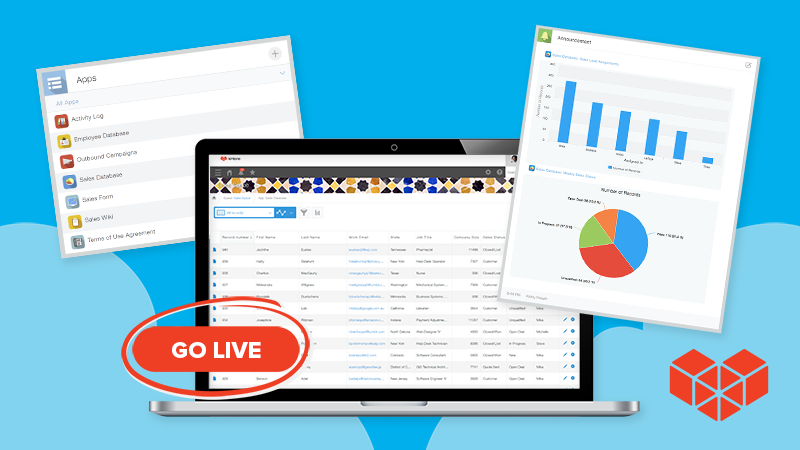The need for effective collaboration
A study published by Harvard Business Review found that “the time spent by managers and employees in collaborative activities has ballooned by 50 percent or more” in the last twenty years.
We’re spending more time talking to others as part of executing our work–but while we’re getting faster in our communication methods, we’re not necessarily getting more effective at the same time.
In-office collaboration and remote work produce the same issues
In the big shift to remote work or hybrid roles, there’s a lot of focus on how remote work might improve or hinder team collaboration.
While office settings and remote ones come with their own unique collaboration challenges, neither one properly solves some of the major issues team collaboration has faced in the last twenty years when it comes to effective collaboration: transparency and accessibility.
Transparency: the ability to see the conversations and data related and adjacent to our work that we aren’t directly involved in.
Accessibility: the ability to view conversations or data we or others had around past situations that relate to current or future challenges.
In-office collaboration often relied on those “have a sec?” conversations or the ability to pull colleagues into a last-minute meeting to talk out an issue.
Similarly, remote work tools with instant messaging features offer the chance to directly message (DM) someone or pull up a last-minute Zoom call to discuss a problem at hand.
But both these methods lack transparency and accessibility. Conversations end up siloed away from anyone who isn’t in the meeting room or on the messaging channel. And none of the problem-solving thinking that goes into the conversation is recorded down in a place that’s easily searchable.
Which is a problem for teams that want to be more efficient in their collaboration and decision-making processes.
To illustrate this:
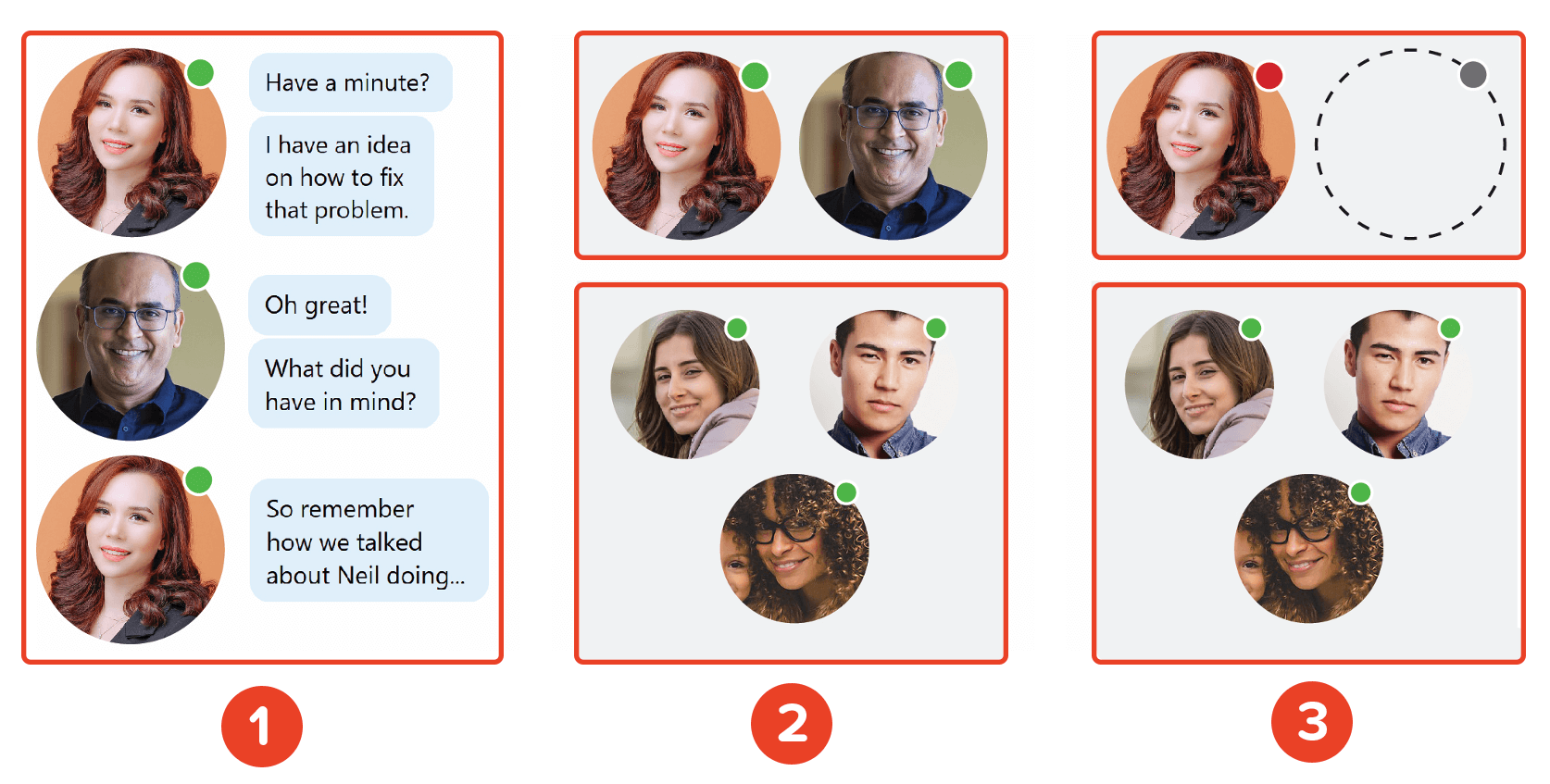
- Co-workers Erica and Bob are trying to solve a prospect qualification problem for their sales team. So they hop on a private Slack channel and start brainstorming, eventually (after some emails, texts and phone calls) coming up with a great solution.
- During their next team meeting, they share how they think the problem can be fixed and their team loves it. Then life moves on, particularly for Erica who goes on maternity leave, and Bob who finds another job.
- Then the sales team runs into the same issue qualifying their prospects, but unfortunately, all the communication between Bob and Erica is lost. So now they’ll have to spend time solving the same problem—something that could have been avoided if information about how Erica and Bob solved it the first time had been captured.
Remote work provides an opportunity to reinvent collaboration
While remote work doesn’t necessarily solve these problems, it does offer companies and teams a fresh opportunity to rebuild their communication habits in a way that solves them.
Remote teams rely entirely on digital tools to communicate. Meaning there’s an opportunity to directly change the very way conversations are being had.
For some teams, that’s regulating the kinds of data and information that is sent over channels (maybe file sharing is done only via email, while day-to-day task updates are delivered via Slack). For others, it’s less about building rules and workarounds to existing solutions and instead looking for tools that encourage new behavior.
Enter Kintone’s Spaces.
What is a Kintone Space?
A Kintone Space is a dedicated workspace within the Kintone platform that helps teams or departments organize and manage all the data, tasks, and communication relevant to their work. Think of it like a digital floor in a company building that hosts you, your coworkers, and anyone else relevant to your day-to-day work.
Here's an example of an HR Space:
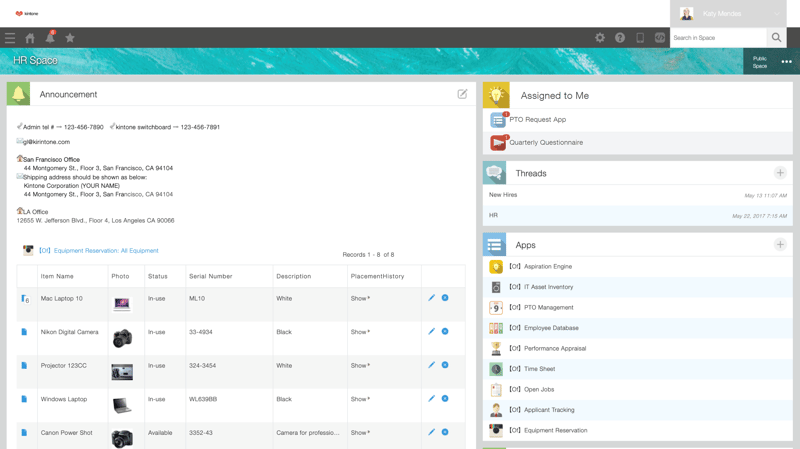
What this looks like in action: a company has one Kintone account, but in that account is a dedicated HR Space for the HR team, a Marketing Space for the marketing team, a Sales Space for the sales team, and so on and so forth.
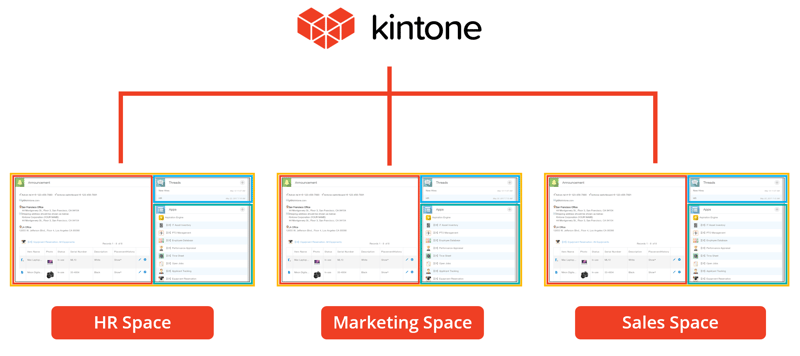
So what does a Space look like in action?
When an account executive on the sales team logs into Kintone, they can navigate to their dedicated Sales Space, where they can see every part of their work and the team’s work. This might look like:
Team’s work:
- Weekly figures by member
- Target goals for the month
- The customer database
- Assigned leads by member
- Conversations between members
Their work:
- Personal lead activity log
- New leads they need to contact
- New tasks from management
- Conversations they’ve had about specific accounts
Spaces allow team members to easily see their own work in the bigger-picture context. Which is one of the key ways Kintone reinvents collaboration: by making conversations and the data around them visible by default.
Transparency without disorganization: the parts of a Space
One of the challenges of making so much information available to teams is that it can simply be a lot of information to keep organized in a cohesive manner. Spaces solve this by being organized into four key parts:
- The Announcement Panel
- The Assigned to Me Panel
- Threads
- Apps
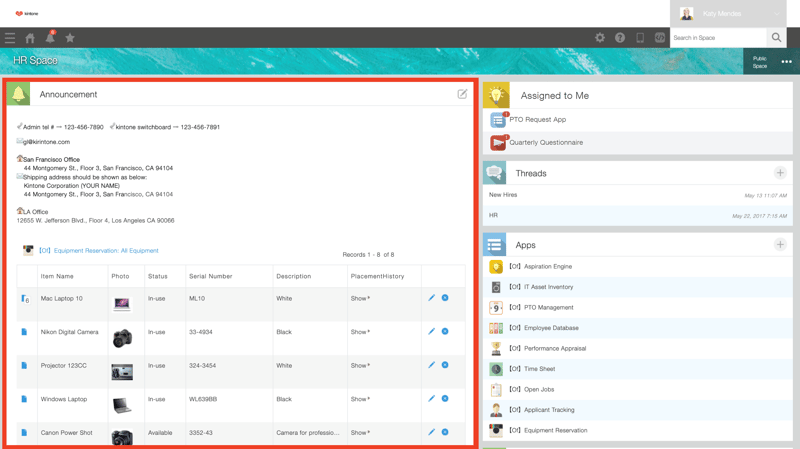
The Announcement Panel can be set up to showcase the key metrics or information the entire team needs to see as part of doing their work. Whether that’s target numbers, important updates from leadership, or more, this section can be configured to showcase a wide variety of info relevant to the entire team in one go.
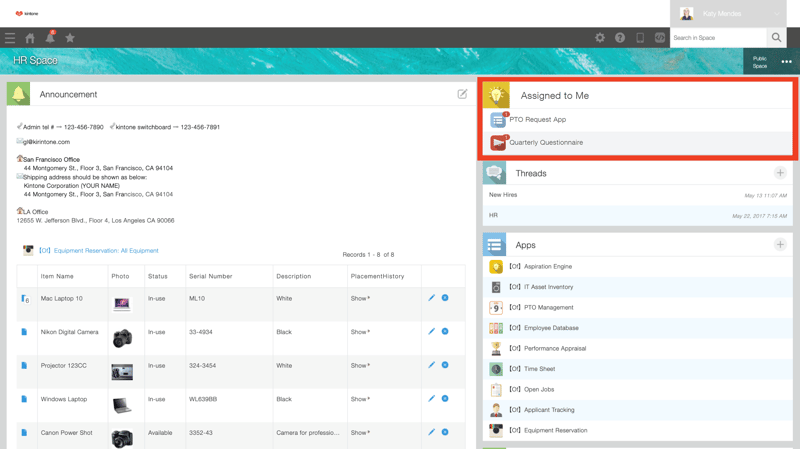
The Assigned to Me Panel showcases tasks that are assigned to the logged-in user. The team member can use this to quickly navigate to tasks they need to deal with for any given day.
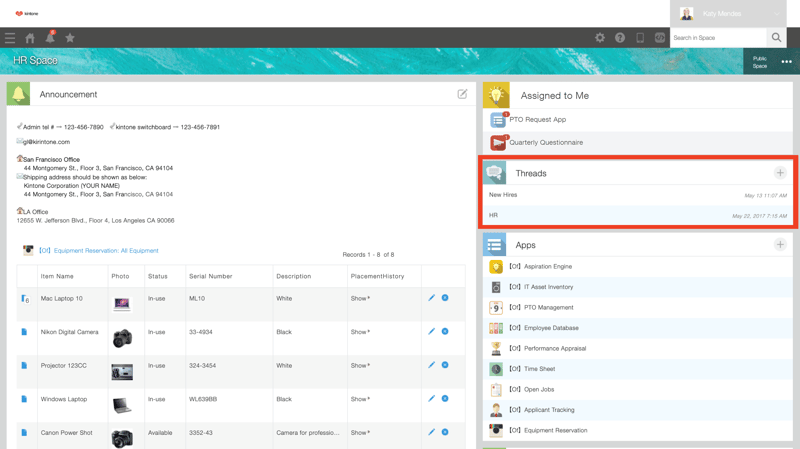
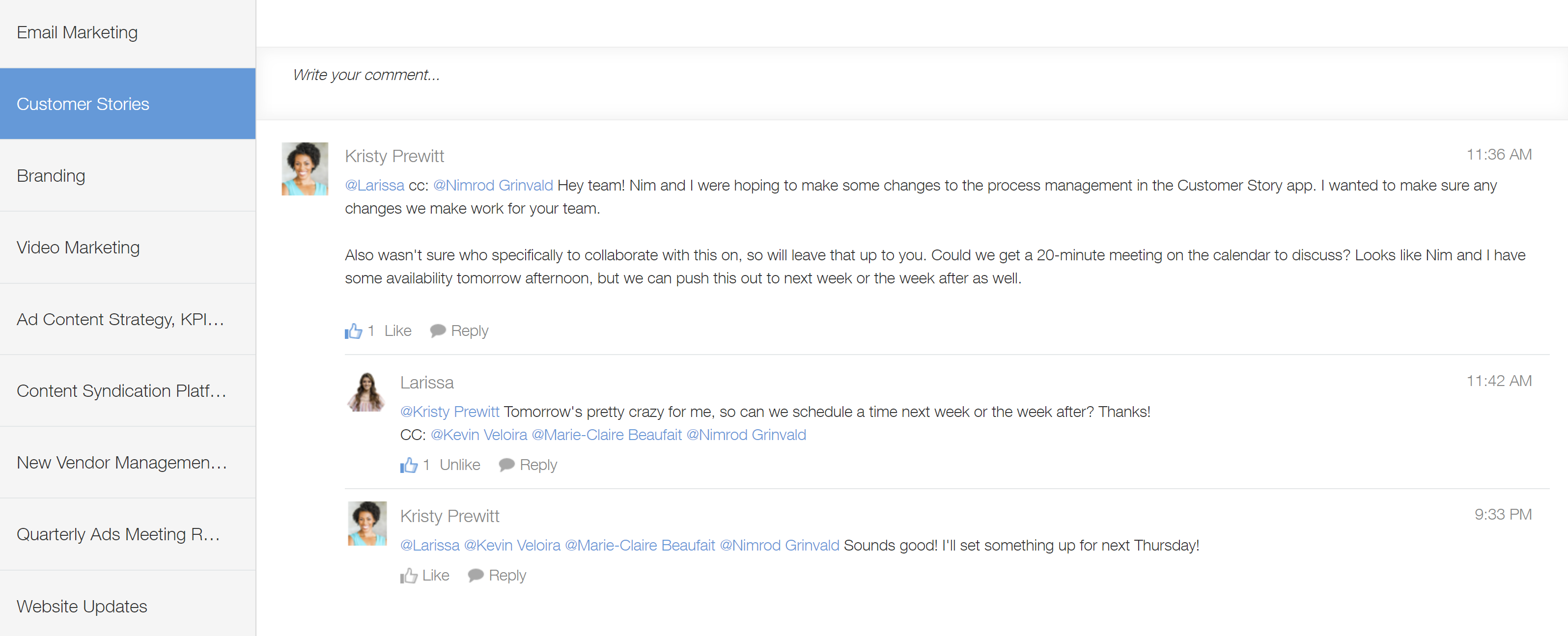
Threads are where public conversations occur. Conversations can be organized by topic or theme; a Marketing Space might contain threads around social media campaigns, vendor suggestions, or customer stories.
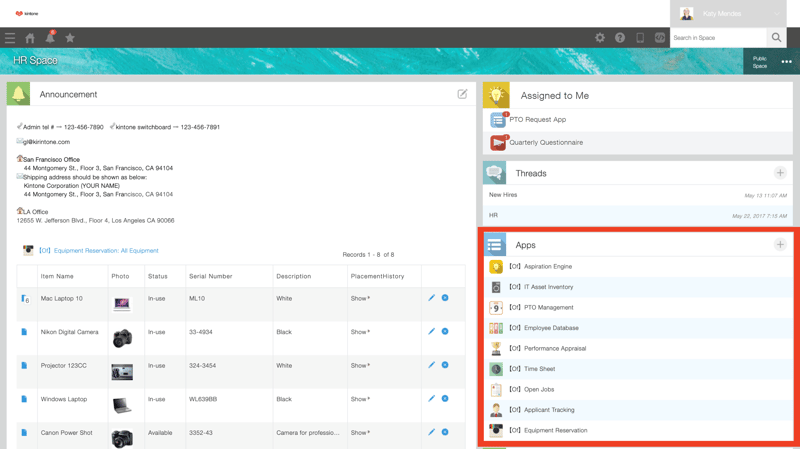
Apps are where the team’s critical data is stored. There can be dozens of database apps within a Space, all containing different kinds of information. An HR Space might contain a PTO Request App, an Employee Database App, and a Business Trip App, among others.
By keeping conversations, data, and tasks visible, centralized, and organized, Spaces allow teams to keep a pulse on conversations they’re not actively participating in but may be relevant to them. So perhaps a sales member mentions in a thread that their lead is considering a competitor; another team member who had that same issue before can see the conversation and offer helpful advice to sway the lead. Even after the two have solved that challenge; their conversation stays in the thread and is easily findable by other team members who come along looking for helpful advice for their own situations.
By keeping all the elements of work visible, members can stay on top of situations that may affect their work or be easily brought into a conversation they can review without needing to have it rehashed.
(In the case where sensitive information must be kept visible to only a few core members of the team or leadership, Kintone’s permission controls make it possible to simplify modify access to that particular data without impacting a team member’s overall access and visibility to what they need most.)
Accessibility means never having the same conversation twice
By keeping data and conversations accessible even after they’ve happened, teams can begin to eliminate the “telephone game” style of information delivery that so often plagues workplaces. A “have a sec?” conversation is fine the first time, but not if three or four coworkers keep having to approach you to have the same conversation over and over.
(Even emails can’t escape this problem, as they often require an action to occur, such as forwarding or cc’ing, before the information can be made available to others; whether in person or email, there is an action that must occur before accessibility can be had. And even then, when a coworker leaves, their email is archived and the information in it is effectively lost to future members.)
Kintone Spaces eliminate this knowledge handoff issue by keeping past information visible, along with a revision history for both conversations and databases.
To re-use the illustration from earlier: if Bob and Erica leave the company, their conversations and information remain on the threads and in the database records even after they’ve gone. Which means team members who remain or join in the future can still learn from the unique knowledge Bob and Erica contributed.
The benefit of dedicated Spaces in a single Kintone account
One of the other growing challenges of modern-day collaboration is the need for cross-collaboration.
One of the unique aspects of Kintone is that while each Space can be dedicated to a specific team or department, all the Spaces are visible to other departments as a default. Which means customer success can access the Sales Space, or marketing can look at business development’s. These other departmental members can also add their thoughts and start (or contribute to) conversations that involve multi-departmental effort.
For example, if marketing receives a technical question from an audience member during a webinar, they can post the question in the Sales Space under a thread dedicated to technical questions. Sales can answer it, and both marketing and other sales members can see it for their own future benefit.
In Summary
Digital collaboration offers companies an unparalleled opportunity to rethink and redesign the way people work together for greater effectiveness. This can be done by either creating rules and guidelines around existing infrastructure or utilizing tools designed with effective collaboration in mind.
Kintone’s Spaces offer teams the chance to lean into a tool that offers transparency and accessibility by default so that teams can:
- See their work and data in a highly-organized big picture
- Reduce the amount of duplicated effort when it comes to sharing data, conversations, and decisions with one another
Collaboration is a growing part of how businesses and teams work, but the process needs refining. For the first time, digital tools are giving us a chance to improve our collaboration in new and innovative ways.
Want to see how Kintone’s Spaces can help keep your team effective?
If you’re interested in learning more about what Kintone’s customizable Spaces and workflows can do for your team’s effectiveness, we recommend scheduling a one-on-one demo with a Kintone product specialist.
It’s easy to spend hours searching for the right tools; with a single meeting you can cut hours into minutes to know if Kintone can help you with your challenges. Want to learn more? Get started below:
About the Author
Michelle is the Content Marketing Specialist at Kintone. She is a content marketing expert with several years in content marketing. She moved to San Francisco in 2015 and has experience working in small businesses, non-profits, and video production firms. She graduated in 2012 with a dual degree in Film and English.






